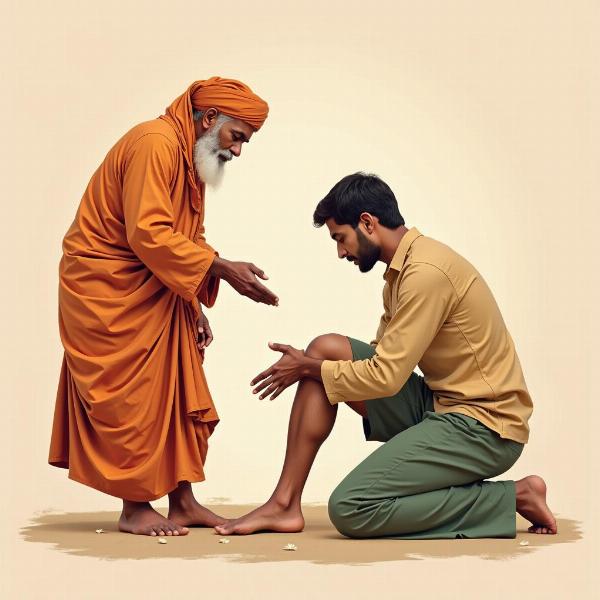Understanding the meaning of “knee” in Hindi is crucial for anyone navigating the language, whether for everyday conversations, medical discussions, or cultural exploration. The knee, a vital joint allowing for movement and flexibility, holds both physical and symbolic significance in Indian culture. Knowing its various Hindi equivalents allows for deeper communication and a richer understanding of the cultural context.
Exploring the Hindi Translations of “Knee”
The most common Hindi word for “knee” is “ghutna” (घुटना). This term is widely understood and used across various Hindi-speaking regions. However, like many words in Hindi, “knee” has several synonyms and regional variations, adding depth and nuance to its meaning.
- “Ghutan” (घुटन): while primarily meaning “suffocation,” this word can also refer to the knee joint in some contexts, particularly when discussing pain or discomfort.
- “Janu” (जानु): This is a more formal and literary term for “knee,” often found in ancient texts, poetry, and religious scriptures.
- “Jangha” (जंघा): This term technically refers to the entire leg from the knee to the ankle, but it can sometimes be used to refer to the knee itself in colloquial language.
Knowing these variations can enhance your understanding of Hindi texts and conversations. For instance, understanding the difference between “ghutna” and “janu” can help differentiate between everyday and formal usage. Imagine trying to describe a knee injury – using the correct term will ensure clarity and precision.
Cultural Significance of the Knee in India
Beyond its anatomical function, the knee holds cultural significance in India. In traditional Hindu customs, touching the feet of elders (“charan sparsh” (चरण स्पर्श)) is a sign of respect. This act often involves bending the knees, symbolizing humility and reverence. Similarly, kneeling or squatting is a common posture for prayer and meditation, signifying surrender and devotion.
 Knee in Indian Culture
Knee in Indian Culture
Common Phrases and Idioms Involving “Knee” in Hindi
Several Hindi idioms and phrases use “knee” metaphorically. For example, “ghutne tek dena” (घुटने टेक देना) means “to surrender” or “to give up.” Another phrase, “ghutnon par chalna” (घुटनों पर चलना), meaning “to crawl on one’s knees,” signifies hardship and struggle. These phrases add color and expressiveness to the Hindi language, reflecting the cultural nuances associated with the knee.
“Meaning of Knee in Hindi” in Different Contexts
The context in which you are searching for “meaning of knee in hindi” can significantly impact the desired information. Are you looking for the literal translation, the anatomical term, or perhaps exploring its cultural implications? Understanding your specific need will guide you toward the most relevant resources. For instance, a medical professional might require precise anatomical terminology, while a language learner might be interested in colloquial usage and idioms.
Conclusion
Knowing the meaning of “knee” in Hindi — from the common “ghutna” to the literary “janu” — opens doors to a deeper understanding of the language and its cultural context. Whether you are learning Hindi, exploring Indian customs, or simply curious about the word’s various dimensions, this knowledge will enrich your experience. Understanding the cultural and symbolic meaning of the knee in India adds a further layer of appreciation for the richness of this ancient culture.
FAQ
- What is the most common Hindi word for “knee”? The most common word is “ghutna” (घुटना).
- What are some other Hindi words for “knee”? Other words include “ghutan” (घुटन), “janu” (जानु), and “jangha” (जंघा), each with slightly different connotations.
- What is the cultural significance of the knee in India? Bending the knee is a sign of respect, often seen in the tradition of touching elders’ feet (“charan sparsh”). Kneeling is also a common posture for prayer and meditation.
- What are some Hindi idioms related to “knee”? “Ghutne tek dena” means “to surrender,” while “ghutnon par chalna” means “to crawl on one’s knees,” signifying hardship.
- Why is understanding the context of “meaning of knee in Hindi” important? The context helps determine the specific information needed, whether it’s a literal translation, anatomical term, or cultural significance.
Meaning-Hindi.in is your premier destination for professional Hindi translation services. Whether you need business document translation, legal document certification, technical manual translation, website localization, or academic paper translation, our expert team provides accurate, culturally sensitive, and reliable linguistic solutions. We also specialize in quick turnaround times for urgent translation needs and cater to a diverse range of specialized industries. Contact us today for a free quote at [email protected] or call us at +91 11-4502-7584. Meaning-Hindi.in helps bridge communication gaps and fosters understanding across languages and cultures.